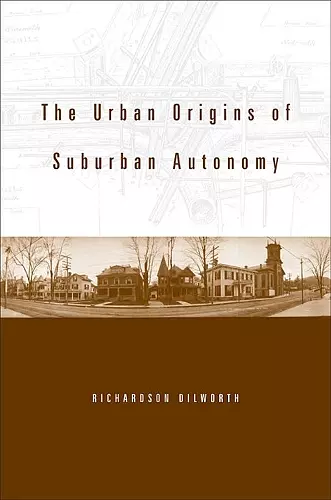The Urban Origins of Suburban Autonomy
Format:Hardback
Publisher:Harvard University Press
Published:30th Mar '05
Currently unavailable, and unfortunately no date known when it will be back

Richard Dilworth has opened a new frontier in the study of urban politics and American political development. He has rediscovered the origins of modern metropolitan politics in the sidewalks, street lamps, sewers, and waterworks of the nineteenth-century city. In the process, he succeeds in joining fascinating historical details with a powerful explanation of how cities and suburbs came to be as they are today. -- Matthew Crenson, Johns Hopkins University and co-author of Downsizing Democracy This is a first-rate study of the interactions among crucial forces that have shaped urban development in the United States. Dilworth explores public demands for improved water supply, sewerage, and street lighting in the late 19th and early 20th centuries, and the different patterns of governmental response in meeting these demands in the New York-New Jersey region. He shows how these interactions prompted some large cities to annex outlying areas and the ways that limited city efforts - coupled with patterns of corruption - led some citizens to press successfully to incorporate their areas as independent suburbs. Dilworth draws upon original sources and so provides us with fresh evidence as well as an important general argument concerned with the evolution of urban society in America. -- Jameson W. Doig, Princeton University and author of, Empire on the Hudson
Using the urbanized area that spreads across northern New Jersey and around New York City as a case study, this book presents a convincing explanation of metropolitan fragmentation--the process by which suburban communities remain as is or break off and form separate political entities.
Using the urbanized area that spreads across northern New Jersey and around New York City as a case study, this book presents a convincing explanation of metropolitan fragmentation—the process by which suburban communities remain as is or break off and form separate political entities. The process has important and deleterious consequences for a range of urban issues, including the weakening of public finance and school integration. The explanation centers on the independent effect of urban infrastructure, specifically sewers, roads, waterworks, gas, and electricity networks. The book argues that the development of such infrastructure in the late nineteenth century not only permitted cities to expand by annexing adjacent municipalities, but also further enhanced the ability of these suburban entities to remain or break away and form independent municipalities. The process was crucial in creating a proliferation of municipalities within metropolitan regions.
The book thus shows that the roots of the urban crisis can be found in the interplay between technology, politics, and public works in the American city.
Richardson Dilworth takes the familiar argument that cities use development policy to compete for residents in our fragmented metropolitan areas and flips it on its head. In Dilworth’s account, development policy is an important causal factor in the creation of the fragmented metropolitan areas in which this competition occurs. His detailed historical accounts of how communities in New York and New Jersey in the late 1800s dealt with issues of incorporation, consolidation, and annexation speak to current interest among urban polities scholars in patterns of suburbanization and the polities of regional coordination. By providing interesting accounts of how a good goes from being defined as private to public (e.g., water, gas), this book may also interest public policy scholars more generally. -- Juliet F. Gainsborough * Perspectives on Politics *
Dilworth has opened a new frontier in the study of urban politics and American political development. He has rediscovered the origins of modern metropolitan politics in the sidewalks, street lamps, sewers, and waterworks of the nineteenth-century city. In the process, he succeeds in joining fascinating historical details with a powerful explanation of how cities and suburbs came to be as they are today. -- Matthew Crenson, Johns Hopkins University, coauthor of Downsizing Democracy
This is a first-rate study of the interactions among crucial forces that have shaped urban development in the United States. Dilworth explores public demands for improved water supply, sewerage, and street lighting in the late nineteenth and early twentieth centuries, and the different patterns of governmental response in meeting these demands in the New York–New Jersey region. He shows how these interactions prompted some large cities to annex outlying areas and the ways that limited city efforts—coupled with patterns of corruption—led some citizens to press successfully to incorporate their areas as independent suburbs. Dilworth draws upon original sources and so provides us with fresh evidence as well as an important general argument concerned with the evolution of urban society in America. -- Jameson W. Doig, Princeton University, author of Empire on the Hudson
- Joint winner of Best Book Award in Urban Politics 2006
- Nominated for Abel Wolman Award 2006
- Nominated for Bancroft Prize 2006
- Nominated for Allan Sharlin Memorial Award 2006
- Nominated for John H. Dunning Prize 2005
ISBN: 9780674015319
Dimensions: unknown
Weight: unknown
280 pages